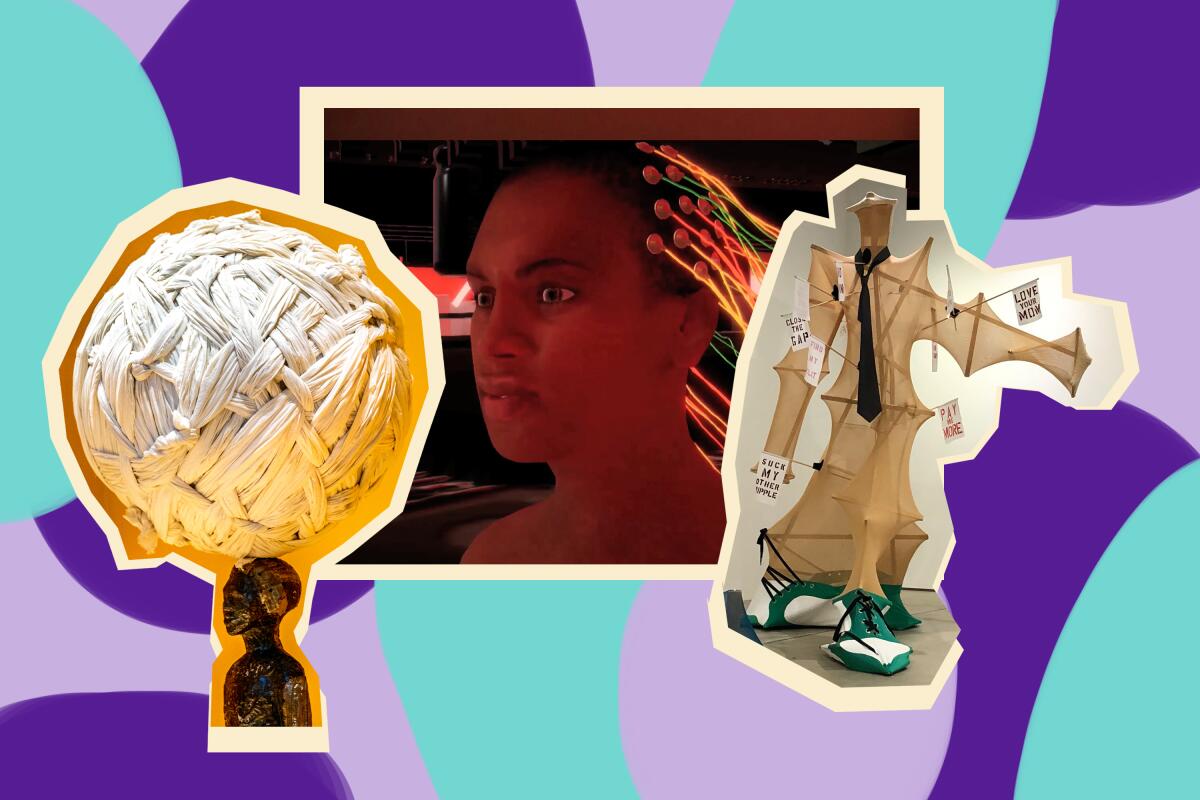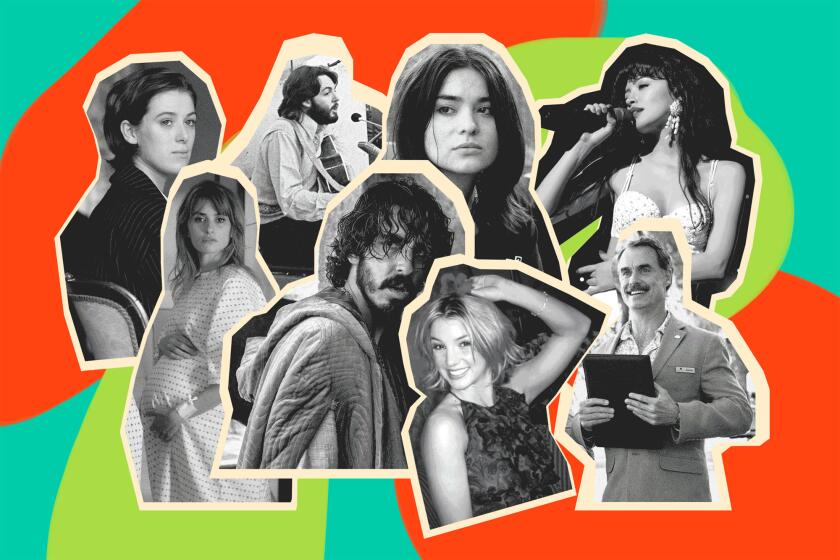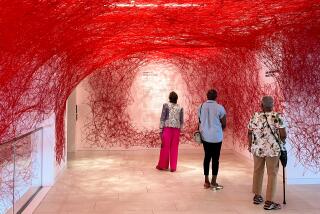From NFTs to long-overdue reckonings, 10 things that shaped the art world in 2021

- Share via
Seen any art lately?
Sometimes a year becomes a marker in social history, and 2021 shall be forever known as the year when right-wing domestic terrorists attacked the U.S. Capitol, leaving dead bodies and a scandalized nation in their wake. Eventually, the horrific benchmark may resonate in cultural offerings.
For now, given the still somewhat topsy-turvy world of art museums and galleries as the COVID-19 pandemic grinds on, simple gratitude is due for art opportunities that have improved greatly over last year at this time. Many (and probably most) places have reopened at the moment with at least some public access. The casual serendipity that accompanies traditional gallery-going, dropping in and breezing out, plus the more directed pleasures of museum visits, aren’t yet back to normal — but maybe next year.
The best of the year’s TV shows, movies, music, games, theater, art, architecture and more.
So, it doesn’t make sense to do the usual “best of” list of exhibitions for 2021. I admired a number of shows (reviews are still posted online), but I’ve compiled instead a list of 10 things that seem especially relevant in the art world this year. Here they are, in no particular order:
1. Long-Overdue Reckonings
Systemic racial segregation in museum exhibitions and gallery representation continued to unravel, with Black artists finally beginning to assume a degree of parity within an art world where white artists have always been rife. The same goes for professional staffing within the field. Some galleries, notably Roberts Projects in Culver City, have been at the forefront of elevating Black artists for many years, while new Black-owned art spaces, such as Band of Vices in West Adams, have opened. Black artists are being added to other gallery rosters and museum exhibition schedules in unprecedented numbers. There’s much more to be done — and all across the BIPOC spectrum — but progress is undeniable.
2. Who Will Succeed Cuno?
Speaking of diversity within the field, a huge opportunity opened up in the summer with the announcement that Getty Trust President and CEO James Cuno, 70, will retire. With its two museums, incomparable research and conservation institutes, influential charitable foundation and enormous piggybank — around $8 billion — the Getty is a powerhouse. A search firm is looking at potential successors to Cuno, who will assume an emeritus role; yet, for four decades, the leadership has been exclusively in the hands of white men. They’ve overseen a wide variety of institutional hits and misses, but it’s past time to broaden the administrative scope at the very top.
3. Two Locales For One Show
Dividing an exhibition between two venues for lack of space at one is probably better than not having the exhibition at all, even if seeing the show requires getting in the car and driving 15 (or 30) miles to get the full picture. That was the case this year with an important survey of Alison Saar’s sculptures at Pasadena’s Armory Center for the Arts and the Benton Museum at Pomona College; and, with the engaging group show “Witch Hunt,” still on view at the UCLA Hammer Museum and the ICA L.A. downtown, which looks at recent feminist art internationally. Cooperation between institutions is admirable, but the split interrupts the cross-referencing among objects central to an exhibition’s purpose. The format is less than ideal.
4. Museums Grapple With Looted Art
The UCLA Fowler Museum made welcome progress on provenance research around sculptures almost surely looted by British military forces in 1897 from the Royal Palace in Benin City in contemporary Nigeria. Return of the illicit items is likely. The Los Angeles County Museum of Art was a bit less forthcoming about its great Benin bronze plaque, though, saying only that “appropriate action” would be taken. Things got a bit stickier in October when Lost Arts of Nepal, a research site that posts on Facebook, identified two masterpieces from LACMA’s impressive South Asian collections that also appear to have been stolen: a 7th century carved-stone temple-doorway lintel from the medieval city-state of Bhaktapur; and a magnificent 16th century wooden sculpture of Chintamani Lokeshvara, a Buddhist deity popular in Kathmandu, from the I Baha Bahi Monastery in Patan.
5. Endowments Are Up
The litany of bad institutional news fomented by the brutal COVID-19 pandemic is long, but one unexpected development is auspicious. Art museum endowments have benefited mightily from a robust investment market. Museums, used to having their hands out to beg for funding, have been quiet about the windfall, but growth of 10%, 20%, even 40% has been recorded in what amounts to a pandemic dividend — from the Hammer Museum at the lower end to the Museum of Contemporary Art, San Diego, at the higher.
6. Deaccessioned Works
In a panicked decision when the pandemic erupted and a financial crisis loomed in spring 2020, the Assn. of Art Museum Directors loosened restrictions on the use of income from art formally removed (or deaccessioned) from museum collections and then sold. A largely farcical virtual symposium at Syracuse University in March tried to justify the unjustifiable, trumpeting the new euphemism of choice — “collection care” — as the dire need. In fact, what was meant was covering plain old costs of basic museum operations like staff salaries, security and conservation, which are the income uses that have always been correctly forbidden when museum art is sold. New York’s spring and fall art auctions were lamentably littered with newly monetized museum art.
7. The NFT Boom
In retrospect, it seems as logical as A-B-C. A: By the start of the new millennium, new art became an asset class, traded like stocks or real estate. B: Cryptocurrency (in the form of Bitcoin) was launched in 2009, introducing a purely digital means of exchange. C: NFTs, or nonfungible-tokens, made each digital token unique and irreplaceable, nudging the cryptocurrency idea toward asset-class art. When the previously unknown artist Mike Winkelmann — a.k.a. Beeple — sold an NFT at a weird March auction for $69 million, the boom was on. Tellingly, almost all critical commentary around artists’ NFTs so far concerns their investment potential, while almost none concerns the art.
8. Where Have the Exhibition Catalogs Gone?
On April Fool’s Day, LACMA opened “NOT I: Throwing Voices (1500 BCE–2020 CE),” an intriguing postmodern look at ventriloquism in relation to art and museums. In September, the Museum of Contemporary Art opened “Pipilotti Rist: Big Heartedness, Be My Neighbor,” an absorbing installation-as-career-survey of the Swiss video artist. (It’s still on view.) Both major shows had been postponed from the prior year due to pandemic closure; unfortunately, neither one came with the usual catalog, just souvenir guides. An exhibition catalog — as scholarly analysis, curatorial framework and historical record — is a measure of institutional commitment to the art. Let’s hope the frustrating absences from the two museums’ primary 2021 exhibition offerings don’t also signal a trend.
9. “Immersive Art Experiences”
Phineas T. Barnum’s famous 1841 dime museum, a family entertainment that highlighted a flea circus, morality plays on the dangers of drinking, sword swallowers and bunkum like a mermaid fabricated from stuffed animal parts, lives on today in the proliferating form of commercial “immersive art experiences.” Essentially high-tech, razzle-dazzle light shows with digitized graphics simply projected at enormous scale on surrounding walls, floor and ceiling, some trumpet famous art-names like Van Gogh and Monet while others go for more generalized gee-whiz surrealism. The inexpensive, working-class entertainment promised by Barnum’s 10-cent entry fee is long gone, however, pricing having ballooned to $30 and up.
10. Meager Offerings at the Resnick
LACMA opened its purpose-built Resnick Pavilion in 2010 to have 45,000 square feet of exhibition space ready and available when it tore down all the original buildings for construction of a new permanent collection home. Those older buildings are gone now, but Resnick offerings have been disappointingly narrow: Of 11 shows since the demolition, 10 have presented Modern and contemporary art almost exclusively. (Ditto two of the three announced so far for 2022.) While exceptional pre-Modern global art languishes in LACMA storage, with a few objects loaned elsewhere, the largest art museum with the most diverse collections west of Chicago has pretty much abandoned art’s global history, shrinking to become a monotonous Modern kunsthalle.
LACMA and UCLA’s Fowler Museum ponder repatriation of so-called Benin bronzes stolen during an 1897 slaughter by British colonists.
More to Read
The biggest entertainment stories
Get our big stories about Hollywood, film, television, music, arts, culture and more right in your inbox as soon as they publish.
You may occasionally receive promotional content from the Los Angeles Times.












